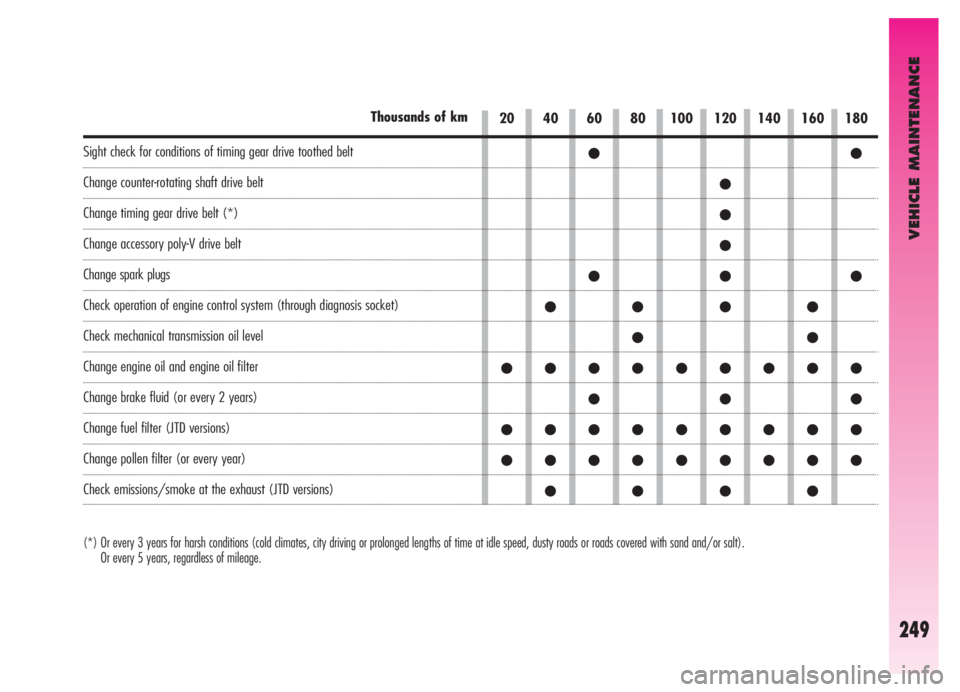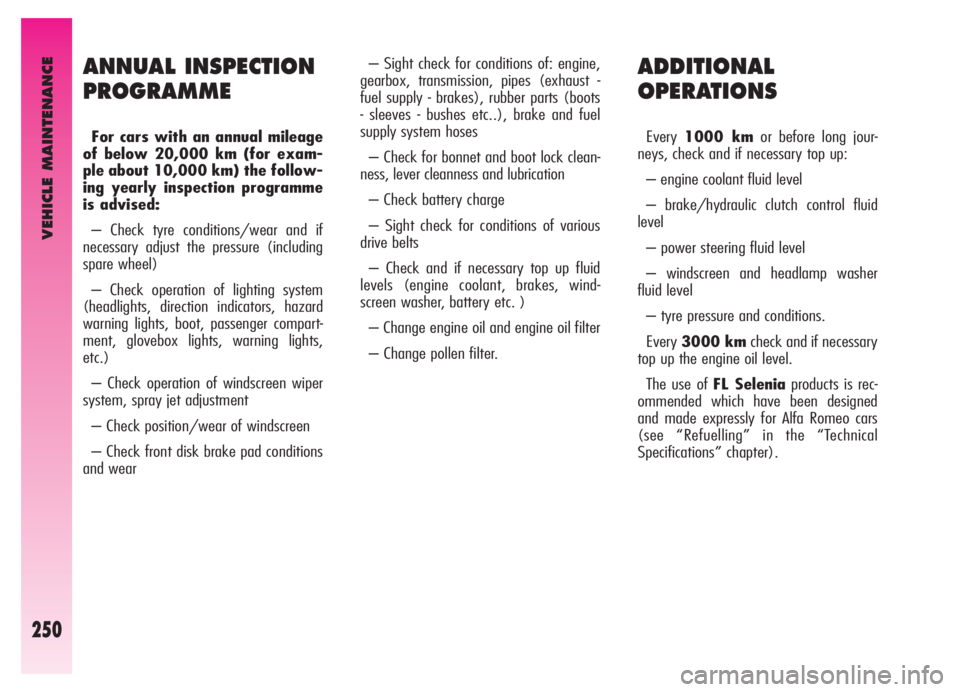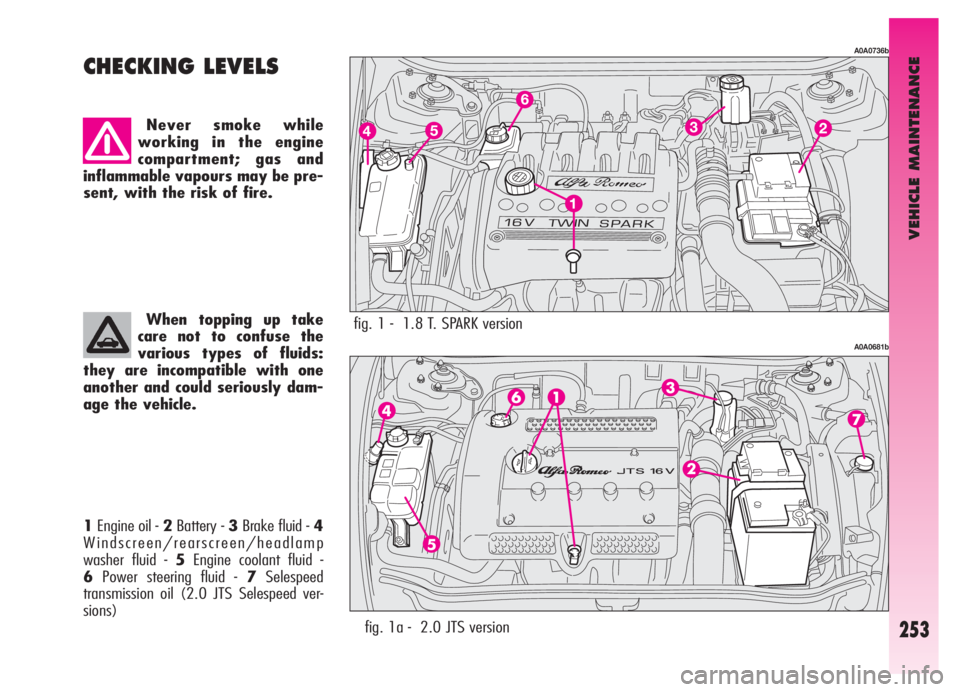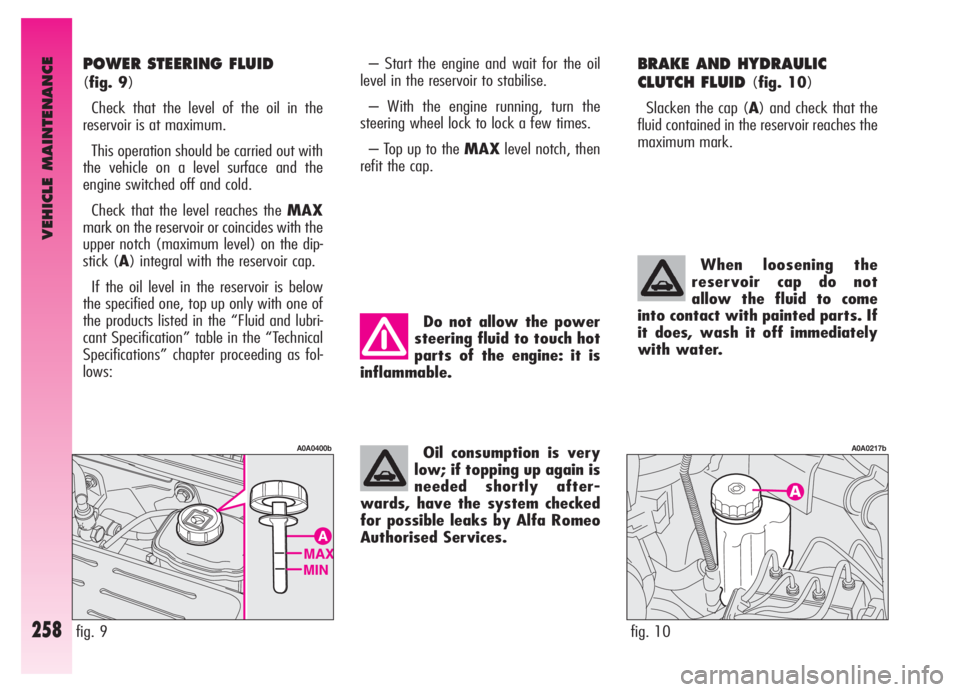Alfa Romeo GT 2005 Owner handbook (in English)
Manufacturer: ALFA ROMEO, Model Year: 2005, Model line: GT, Model: Alfa Romeo GT 2005Pages: 307, PDF Size: 6.05 MB
Page 251 of 307

●●
●
●
●
●●●
●●●●
●●
●●●●●●●●●
●●●
●●●●●●●●●
●●●●●●●●●
●●●●
VEHICLE MAINTENANCE
249
20 40 60 80 100 120 140 160 180Thousands of km
(*) Or every 3 years for harsh conditions (cold climates, city driving or prolonged lengths of time at idle speed, dusty roads or roads covered with sand and/or salt).
Or every 5 years, regardless of mileage.
Sight check for conditions of timing gear drive toothed belt
Change counter-rotating shaft drive belt
Change timing gear drive belt (*)
Change accessory poly-V drive belt
Change spark plugs
Check operation of engine control system (through diagnosis socket)
Check mechanical transmission oil level
Change engine oil and engine oil filter
Change brake fluid (or every 2 years)
Change fuel filter (JTD versions)
Change pollen filter (or every year)
Check emissions/smoke at the exhaust (JTD versions)
Page 252 of 307

VEHICLE MAINTENANCE
250
ADDITIONAL
OPERATIONS
Every 1000 kmor before long jour-
neys, check and if necessary top up:
– engine coolant fluid level
– brake/hydraulic clutch control fluid
level
– power steering fluid level
– windscreen and headlamp washer
fluid level
– tyre pressure and conditions.
Every 3000 kmcheck and if necessary
top up the engine oil level.
The use of FL Seleniaproducts is rec-
ommended which have been designed
and made expressly for Alfa Romeo cars
(see “Refuelling” in the “Technical
Specifications” chapter).
ANNUAL INSPECTION
PROGRAMME
For cars with an annual mileage
of below 20,000 km (for exam-
ple about 10,000 km) the follow-
ing yearly inspection programme
is advised:
– Check tyre conditions/wear and if
necessary adjust the pressure (including
spare wheel)
– Check operation of lighting system
(headlights, direction indicators, hazard
warning lights, boot, passenger compart-
ment, glovebox lights, warning lights,
etc.)
– Check operation of windscreen wiper
system, spray jet adjustment
– Check position/wear of windscreen
– Check front disk brake pad conditions
and wear– Sight check for conditions of: engine,
gearbox, transmission, pipes (exhaust -
fuel supply - brakes), rubber parts (boots
- sleeves - bushes etc..), brake and fuel
supply system hoses
– Check for bonnet and boot lock clean-
ness, lever cleanness and lubrication
– Check battery charge
– Sight check for conditions of various
drive belts
– Check and if necessary top up fluid
levels (engine coolant, brakes, wind-
screen washer, battery etc. )
– Change engine oil and engine oil filter
– Change pollen filter.
Page 253 of 307

VEHICLE MAINTENANCE
251
IMPORTANT
Engine oil
Should prevailing use of the car be under
one of the following specially heavy con-
ditions:
– trailer or caravan towing
– dusty roads
– short distances (less than 7-8 km)
repeated and with external temperatures
below zero
– frequently idling engines or long dis-
tance low speed driving or in case of a
long term inactivity
replace engine oil more frequently than
required on Service Schedule.IMPORTANT
Diesel filter
The different grades of purity in diesel
fuel normally available might make it nec-
essary to replace the filter more frequent-
ly than indicated in the Service Schedule.
If the engine misfires it shows the filter
needs changing.IMPORTANT
Air cleaner
Using the car on dusty roads change the
air cleaner more frequently than specified
in the Schedule Maintenance Programme.
For any doubts concerning the intervals
between the engine oil and air cleaner
replacement in relation to how the vehicle
is used, contact Alfa Romeo Authorised
Services.
Page 254 of 307

VEHICLE MAINTENANCE
252
Vehicle maintenance
should be entrusted to
Alfa Romeo Authorised
Services. For routine and minor
maintenance operations you wish
to carry out yourself, always
make sure you have the proper
equipment, genuine Alfa Romeo
spares and the necessary fluids;
do not however carry out these
operations if you have no experi-
ence.IMPORTANT
Pollen filter
If the vehicle is used frequently in dusty
or heavily polluted environments it is
advisable to replace the filtering element
more frequently; in particular it should be
replaced if a reduction of the amount of
air admitted to the passenger compart-
ment is noted. IMPORTANT
Battery
It is advisable to check the battery
charge, preferably at the onset of winter,
to prevent the possibility of the electrolyte
freezing.
This check should be carried out more
frequently if the car is used mainly for
short trips, or if it is fitted with accessories
that permanently absorb electricity even
with the ignition key removed, especially
in the case of after market accessories.
If the vehicle is used in hot climates or
particularly harsh conditions it is wise to
check the level of the battery fluid (elec-
trolyte) more frequently than specified in
the Scheduled Maintenance Programme.
Page 255 of 307

VEHICLE MAINTENANCE
253
1Engine oil - 2Battery - 3Brake fluid -4
Windscreen/rearscreen/headlamp
washer fluid - 5Engine coolant fluid -
6Power steering fluid - 7Selespeed
transmission oil (2.0 JTS Selespeed ver-
sions)
CHECKING LEVELS
Never smoke while
working in the engine
compartment; gas and
inflammable vapours may be pre-
sent, with the risk of fire.
When topping up take
care not to confuse the
various types of fluids:
they are incompatible with one
another and could seriously dam-
age the vehicle.fig. 1 - 1.8 T. SPARK version
A0A0736b
A0A0681b
fig. 1a - 2.0 JTS version
Page 256 of 307

VEHICLE MAINTENANCE
254fig. 3 - JTD 16Vversion1Engine oil - 2Battery - 3Brake fluid -4
Windscreen/rearscreen/headlamp
washer fluid - 5Engine coolant fluid -
6Power steering fluid
A0A0396b A0A0683b
fig. 2 - 3.2 V6version
1Engine oil - 2Battery - 3Brake fluid -4
Windscreen/rearscreen/headlamp
washer fluid - 5Engine coolant fluid -
6Power steering fluid
Page 257 of 307

VEHICLE MAINTENANCE
255
ENGINE OIL (fig. 4-4a-5-6)
The engine oil should be checked with
the vehicle on a level surface a few min-
utes (about 5) after the engine has been
switched off.
Remove the dipstick (A), clean it, put it
back in completely, remove it and check
that the level is within the MINand
MAXmarks on the dipstick. The interval
between the MINandMAXmarks cor-
respond to about one litre of oil.When the engine is hot,
take care when working
inside the engine com-
partment to avoid burns.
Remember that when the engine
is hot, the fan may cut in: danger
of injury.
Do not add oil with spec-
ifications (classification,
viscosity) other than
those of the oil already in the
engine.
fig. 4 - 1.8 T. SPARK version
A0A0737b
fig. 6 - JTD 16Vversion
A0A0398b
AB
fig. 5 - 3.2 V6version
A0A0406b
If the oil level is near or even below the
MINmark, add oil through the filter neck
(B), until reaching the MAXmark.
IMPORTANTIf a routine check
reveals that the level is above the MAX
mark, contact Alfa Romeo Authorised
Services to have the correct level restored.
IMPORTANTAfter topping up the oil,
before checking the level again, run the
engine a few seconds and wait for a few
minutes ater stopping it.
fig. 4a - 2.0 JTS version
A0A0682b
Page 258 of 307

VEHICLE MAINTENANCE
256
Used engine oil and filter
contain harmful sub-
stances for the environ-
ment. Contact Alfa Romeo
Authorised Services to have the
oil and the filter changed, as they
are equipped to dispose of the
waste oil and filters respecting
nature and the law.
SELESPEED TRANSMISSION
OIL
(fig. 7)
The Selespeed transmission oil should be
checked with the vehicle on a level sur-
face and with the engine stopped and
cold.
To check the level, proceed as follows:
– turn the ignition key to MAR;
– disconnect the breather tube and
remove the cap (A) checking that the
level corresponds with the MAXmark on
the dipstick integrated with the cap;
– if the oil is below the MAXmark, top
up to reach the correct level;Do not add oil with spec-
ifications other than that
already in the gearbox.
fig. 7
A0A0197b
Used gearbox oil con-
tains dangerous sub-
stances for the environ-
ment. For changing the oil we
advise contacting Alfa Romeo
Authorised Services who are
equipped for disposing of used oil
respecting nature and the law.
Be very careful working
inside the engine com-
partment if the engine is
hot: danger of burns. Remember
that the fan may cut in if the
engine is very hot: danger of
injury.
Engine oil consumption
Max engine oil consumption is usually
400 grams every 1000 km.
During the initial period of use the
engine settles, therefore engine oil con-
sumption may be considered stabilised
only after the first 5000 ÷ 6000 km.
IMPORTANTEngine oil consumption
depends on the way of driving and the
conditions of use of the vehicle.– after refitting the cap, insert the
breather tube firmly on the housing on the
cap and turn the ignition key to STOP.
Page 259 of 307

VEHICLE MAINTENANCE
257
The cooling system is
pressurised. If necessary,
replace the cap only with
another genuine one, otherwise
the system efficiency could be
compromised. Do not remove the
tank cap with the engine hot:
danger of burns.
The engine cooling sys-
tem uses antifreeze pro-
tective fluid PARAFLU UP.
For topping up use the same type
of fluid contained in the cooling
system. The PARAFLU UP fluid
cannot be mixed with any other
type of fluid. Should it occur,
never start the engine and contact
Alfa Romeo Authorised Services.ENGINE COOLANT FLUID
(fig. 8)
Do not remove the cap
when the engine is hot:
danger of burns.
The level of the coolant in the header
tank (reservoir) should be checked with
the engine cold and the car on a level sur-
face and it should be between the MIN
andMAXmarks on the tank.
fig. 8
A0A0240b
If the level is low, loosen the header tank
cap (A) and slowly pour a mixture of 50%
distilled water and 50% PARAFLU UP
FL Seleniathrough the filler neck until
nearing the MAXmark.
The antifreeze mixture of 50%
PARAFLU UPand 50% distilled water
guarantees protection down to –35 °C.
Page 260 of 307

Oil consumption is very
low; if topping up again is
needed shortly after-
wards, have the system checked
for possible leaks by Alfa Romeo
Authorised Services.
VEHICLE MAINTENANCE
258
When loosening the
reservoir cap do not
allow the fluid to come
into contact with painted parts. If
it does, wash it off immediately
with water. Do not allow the power
steering fluid to touch hot
parts of the engine: it is
inflammable.
fig. 10
A0A0217b
fig. 9
A0A0400b
BRAKE AND HYDRAULIC
CLUTCH FLUID
(fig. 10)
Slacken the cap (A) and check that the
fluid contained in the reservoir reaches the
maximum mark.
POWER STEERING FLUID
(fig. 9)
Check that the level of the oil in the
reservoir is at maximum.
This operation should be carried out with
the vehicle on a level surface and the
engine switched off and cold.
Check that the level reaches the MAX
mark on the reservoir or coincides with the
upper notch (maximum level) on the dip-
stick (A) integral with the reservoir cap.
If the oil level in the reservoir is below
the specified one, top up only with one of
the products listed in the “Fluid and lubri-
cant Specification” table in the “Technical
Specifications” chapter proceeding as fol-
lows:– Start the engine and wait for the oil
level in the reservoir to stabilise.
– With the engine running, turn the
steering wheel lock to lock a few times.
– Top up to the MAXlevel notch, then
refit the cap.